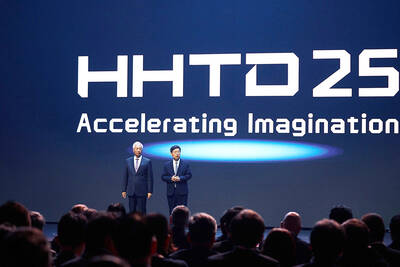DRAM chipmaker Nanya Technology Corp (南亞科技) yesterday saw last month’s revenue climb to a record high as the company offered a bulked-up, more cost-effective 20-nanometer chip to satisfy robust customer demand.
The gain marked the third consecutive month that the chipmaker broke a company record, as it benefits from the longest boom period for the DRAM industry since the second half of 2016.
Revenue last month rose 3.12 percent to NT$8.59 billion (US$280.85 million), compared with NT$8.33 billion in May and NT$4.19 billion in June last year, bringing second-quarter revenue up 30.85 percent to NT$24.6 billion from NT$18.8 billion in the first quarter, a company statement said.
Planning to convert more chips from 30 nanometer to 20 nanometer technology and to sell more of the higher-priced DDR4 chips, Nanya Technology expects second-quarter shipments to grow at a quarterly rate of 15 percent from the first quarter.
DDR4 chips deliver 20 to 30 percent more of a price premium than the DDR3 chips, the company said, adding that it expects shipments this year to increase 48 percent year-on-year.
The revenue growth was also supported by constant price increases. DRAM chip prices have been increasing since the second half of 2016 due to a supply crunch, although price increases are slowing.
The average selling price during the second quarter was expected to increase by a low-to-middle single digit percentage as demand continued to outpace supply, following a 6.1 percent price increase in the first quarter, Nanya Technology said in May.
The price uptrend is expected to carry into the current quarter, driven by seasonal demand for DRAM chips used in servers and mobile phones, the chipmaker projected at the time.
In particular, most high-end smartphones are to be equipped with bigger memory of about 6 gigabytes, Nanya Technology said.
Increasing replacement demand for entry-level smartphones in developing countries such as India and Indonesia would also spur demand for memory chips, it said.
In the first six months of this year, revenue soared 74.56 percent to NT$43.39 billion, compared with NT$24.86 billion during the same period last year, it said.
About 65 percent of the chipmaker’s revenue came from niche DRAM chips for consumer electronics such as TVs, while 15 percent came from low-power DRAM chips for mobile phones and about 10 percent from PC DRAM chips, it said.
Shares in Nanya Technology yesterday inched up 0.99 percent to close at NT$81.8 in Taipei trading.

Shiina Ito has had fewer Chinese customers at her Tokyo jewelry shop since Beijing issued a travel warning in the wake of a diplomatic spat, but she said she was not concerned. A souring of Tokyo-Beijing relations this month, following remarks by Japanese Prime Minister Sanae Takaichi about Taiwan, has fueled concerns about the impact on the ritzy boutiques, noodle joints and hotels where holidaymakers spend their cash. However, businesses in Tokyo largely shrugged off any anxiety. “Since there are fewer Chinese customers, it’s become a bit easier for Japanese shoppers to visit, so our sales haven’t really dropped,” Ito

The number of Taiwanese working in the US rose to a record high of 137,000 last year, driven largely by Taiwan Semiconductor Manufacturing Co’s (TSMC, 台積電) rapid overseas expansion, according to government data released yesterday. A total of 666,000 Taiwanese nationals were employed abroad last year, an increase of 45,000 from 2023 and the highest level since the COVID-19 pandemic, data from the Directorate-General of Budget, Accounting and Statistics (DGBAS) showed. Overseas employment had steadily increased between 2009 and 2019, peaking at 739,000, before plunging to 319,000 in 2021 amid US-China trade tensions, global supply chain shifts, reshoring by Taiwanese companies and

Taiwan Semiconductor Manufacturing Co (TSMC) Chairman C.C. Wei (魏哲家) and the company’s former chairman, Mark Liu (劉德音), both received the Robert N. Noyce Award -- the semiconductor industry’s highest honor -- in San Jose, California, on Thursday (local time). Speaking at the award event, Liu, who retired last year, expressed gratitude to his wife, his dissertation advisor at the University of California, Berkeley, his supervisors at AT&T Bell Laboratories -- where he worked on optical fiber communication systems before joining TSMC, TSMC partners, and industry colleagues. Liu said that working alongside TSMC

TECHNOLOGY DAY: The Taiwanese firm is also setting up a joint venture with Alphabet Inc on robots and plans to establish a firm in Japan to produce Model A EVs Manufacturing giant Hon Hai Precision Industry Co (鴻海精密) yesterday announced a collaboration with ChatGPT developer OpenAI to build next-generation artificial intelligence (AI) infrastructure and strengthen its local supply chain in the US to accelerate the deployment of advanced AI systems. Building such an infrastructure in the US is crucial for strengthening local supply chains and supporting the US in maintaining its leading position in the AI domain, Hon Hai said in a statement. Through the collaboration, OpenAI would share its insights into emerging hardware needs in the AI industry with Hon Hai to support the company’s design and development work, as well